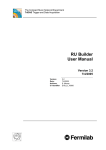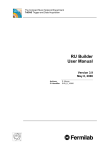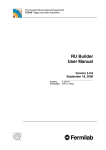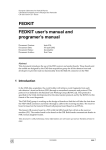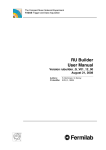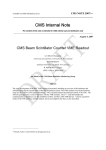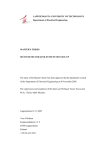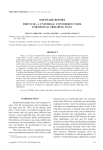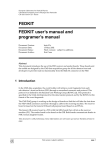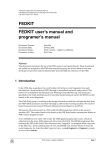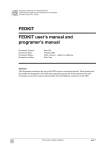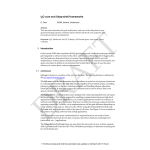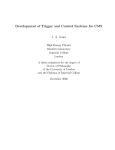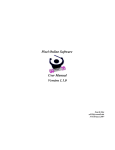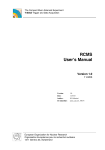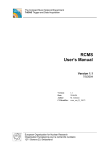Download RU Builder User Manual
Transcript
The Compact Muon Solenoid Experiment TriDAS Trigger and Data Acquisition RU Builder User Manual Version 3.3 August 16, 2005 Version: Date: Authors: CI identifier 3.3 August 16, 2005 S. Murray EVB_D_18306 Revision History Date Version Description Author July 11, 2003 0.1 Document creation S. Murray July 31, 2003 1.0 Finalization of version 1.0 J. Gutleber May 24, 2004 2.0 Updated for version 2.0 of the EVB, now referred to as the RU builder S. Murray November 1, 2004 2.1 Updated for version 2.1 of the RU builder S. Murray May 2, 2005 3.0 Updated for version 3.0 of the RU builder S. Murray July 4, 2005 3.2 Updated for version 3.2 of the RU builder S. Murray August 16, 2005 3.3 Updated for version 3.3 of the RU builder S. Murray CI Record Field Description CI Identifier EVB_D_18306 Description Describes the RU builder for an integrator who will put the builder into a full DAQ system Submission Date August 16, 2005 Submitted By S. Murray Components None Dependencies/Related Version 3.2.2 of the XDAQ core framework External Identifier None Point of Contact S. Murray ([email protected]) Comments None Physical Location http://smurray.home.cern.ch/smurray/RUB_V3_3.doc Table of Contents 1 Introduction 1.1 Document purpose and scope 1.2 Intended readership 1.3 System requirements and dependencies 1.4 References 1.5 Definitions, Acronyms and Abbreviations 6 6 6 6 7 7 2 RU builder overview 2.1 How the RU builder fits within the EVB 2.2 What the EVB does 2.3 The RU builder applications 8 8 9 9 3 RU builder application FIFOs 3.1 BU FIFOs 3.2 EVM FIFOs 3.3 RU FIFOs 10 10 11 12 4 I2O interface 4.1 TA/EVM interface 4.2 RU/RUI interface 4.3 BU/FU interface 13 14 16 17 5 Application state machines 5.1 Commonalities of the application finite state machines 5.2 BU, EVM and RU finite state machines 21 21 22 6 Starting the RU builder 23 7 Stopping the RU builder 24 8 Exported configuration parameters 25 9 How to obtain and build the RU builder 9.1 Checking out the source code from CVS 9.2 Building the application libraries 28 28 29 10 RU builder self test 29 11 Configuration guidelines 32 List of Figures Figure 1 RU builder applications and how they interact with the rest of the EVB ...................8 Figure 2 BU FIFOs ..................................................................................................................10 Figure 3 EVM FIFOs...............................................................................................................11 Figure 4 RU FIFOs ..................................................................................................................12 Figure 5 External I2O interfaces of the RU builder.................................................................13 Figure 6 TA/EVM interface sequence diagram.......................................................................14 Figure 7 RU/RUI interface sequence diagram.........................................................................16 Figure 8 BU/FU interface sequence diagram...........................................................................17 Figure 9 FSTN of a RU builder application.............................................................................21 Figure 10 BU, EVM and RU FSTNs.......................................................................................22 Figure 11 HyperDAQ web page for self test ...........................................................................30 Figure 12 RUBuilderTester web page .....................................................................................31 Figure 13 RUBuilderTester control web page .........................................................................31 Figure 14 Running RU builder ................................................................................................31 List of Tables Table 1 Exported configuration parameters.............................................................................25 1 Introduction User Manual 1 2 3 4 5 6 7 8 9 10 11 12 RU Builder Date: 8/16/2005 1 Introduction The RU builder is a distributed XDAQ application that is part of a larger system called the event builder (EVB). The CMS data acquisition group is presently developing the EVB as described in the TriDAS TDR [1]. This document explains how to obtain, build and configure version 3.3 of the RU builder. The following features are introduced with version 3.3 of the RU builder: • • • Example RUI generates super-fragments with FRL and FED headers/trailers Example FU checks FRL and FED headers/trailers of RUI super-fragments Bug fix - RU builder applications no longer crash their executive when they go to the Failed state 13 1.1 Document purpose and scope 14 15 16 17 18 19 20 21 22 23 24 25 The goal of thi s document is to enable the reader to integrate the RU builder into a “running system” composed of the RU builder itself, a trigger source, one or more event data sources, one or more data sinks and some form of run-control. The RU builder cannot run without the components just listed. This document describes how to obtain, build and configure the RU builder. This document does not describe the other components of a “running system”, such as run control software or how to setup a trigger or event data source. It is also not the purpose of this document to describe the internal workings of the RU builder. Developers are referred to the source code for such information. The code has been structured and commented so that it can be easily read and understoo d. It is recommended to use Doxygen to generate documentation from the code, as compatible comment tags have been used. If the reader is not familiar with Doxygen, then they are referred to its website: http://www.doxygen.org It must be emphasized that the RU builder is still under development and subject to change. No description of the RU builder given in this document can be relied upon to be valid beyond this release. 26 27 1.2 Intended readership 28 29 30 31 32 33 This document is intended for a system integrator - someone that needs to integrate the RU builder into a data acquisition system (DAQ). It is assumed that the DAQ system is based on the XDAQ framework. If the reader is not familiar with this framework, then they are referred to the XDAQ website: http://xdaq.web.cern.ch/xdaq. 34 1.3 System requirements and dependencies 35 36 37 38 39 Version 3.3 of the RU builder only supports the Linux operating system running on an Intel x86 processor. The code was tested using version 3.2.3 of gcc. This version of the RU builder is dependent on version 3.2.2 of the XDAQ core framework. CERN PH/CMD - 2005 Page 6 of 32 1 Introduction User Manual 1 2 3 4 5 6 7 RU Builder Date: 8/16/2005 1.4 References [1] The CMS collaboration, The Trigger and Data Acquisition project, Volume II, Data Acquisition & High-Level Trigger. CERN/LHCC 2002-26, ISBN 92-9083-111-4 1.5 Definitions, Acronyms and Abbreviations 8 BU CVS DAQ EVB EVM FED FSTN FU Builder Unit Concurrent Versioning System Data Acquisition system Event builder Event Manager Front End Driver Finite State Transition Network Filter Unit I2O RU RUI TA TDR TriDAS XDAQ Intelligent Input/Output Readout Unit Readout Unit Input Trigger Adapter Technical Design Report Trigger and Data Acquisition Cross platform data acquisition toolkit CERN PH/CMD - 2005 Page 7 of 32 2 RU builder overview User Manual 1 RU Builder Date: 8/16/2005 2 RU builder overview 2 3 4 5 6 7 8 9 10 11 12 13 14 15 16 17 18 19 20 21 22 23 24 25 26 27 28 29 30 31 32 33 34 35 36 37 38 39 40 41 2.1 How the RU builder fits within the EVB The RU builder is a component of a larger system called the event builder (EVB). The EVB is a distributed application that reads out event fragments from one set of nodes and assembles them into entire events in another set of nodes. Figure 1 shows the applications of the RU builder and how they interact with the rest of the EVB. FED 0 FED m Fragments FED builder RUI 0 RUI n Super-fragments Trigger credits Trigger TA RU 0 EVM RU n RU builder BU 0 BU p Trigger data Discards Allocates Events FU 0 FU q Permanent storage Figure 1 RU builder applications and how they interact with the rest of the EVB 42 43 The external interfaces of the RU builder assume that triggers are given to the EVM in the same order as their corresponding event data is given to the RUs. 44 CERN PH/CMD - 2005 Page 8 of 32 2 RU builder overview User Manual 1 2 3 4 5 6 7 8 9 10 11 12 13 14 15 16 17 18 19 20 21 22 23 24 RU Builder Date: 8/16/2005 2.2 What the EVB does For each event the EVB: • • • • • • Reads out the trigger data. This trigger data will become the first super-fragment of the event. Reads out the fragments of the event from the detector front-end drivers (FEDs). Builds the fragments into RU super-fragments using the FED builder. Builds the whole event using the RU builder. The whole event is the trigger super-fragment plus the set of RU super-fragments. Decides whether or not the event is interesting for physics using the filter units (FUs). Sends the event to permanent storage if it is interesting for physics, or discards it if it is not. 2.3 The RU builder applications The RU builder consists of a single event manager (EVM), one or more readout units (RUs) and one or more builder units (BUs). The EVM is responsible for controlling the flow of data through the RU builder. The RUs are responsible for buffering super-fragments until they are requested by the BUs. The BUs are responsible for building and buffering events until they are requested by the filter units (FUs). The trigger adapter (TA), readout unit inputs (RUIs) and filter units (FUs) are external to the RU builder. The TA is responsible for interfacing the DAQ trigger to the EVM. The RUIs are responsible for pushing super-fragment data from the FED builder into the RUs. The FUs are responsible for selecting interesting events for permanent storage. CERN PH/CMD - 2005 Page 9 of 32 3 RU builder application FIFOs User Manual RU Builder Date: 8/16/2005 1 3 RU builder application FIFOs 2 3 4 5 6 7 The RU builder applications use FIFOs to keep track of requests, trigger data and event data. Knowledge of these FIFOs is required in order to correctly configure the RU builder. This chapter is divided into three sections, one for the BU, one for the EVM and one for the RU. Each section gives a brief description of the application’s behavior and how its FIFOs are used. 8 3.1 BU FIFOs 9 10 11 12 13 14 15 16 17 18 19 20 21 22 23 24 25 26 27 28 29 30 31 32 33 34 35 36 37 38 39 40 41 42 43 44 45 46 A BU is responsible for building events. An event is composed of one trigger super-fragment and N RU super-fragments, where N is the number of RUs. To understand the internal FIFOs of a BU, it is first necessary to know its dynamic behavior. Figure 2 shows the internal FIFOs of a BU. With free capacity available, a BU requests the EVM to allocate it an event (step 1). The EVM confirms the allocation by sending the BU the event id and trigger data of an event (step 2) . This trigger data is the first superfragment of the event. The BU now requests the RUs to send it the rest of the event’s super-fragments (step 3). The BU builds the super-fragments it receives from the RUs (step 4) into a whole event within its resource table (step 5). FUs can ask a BU to allocate them events (step 6). A BU services a FU request by asking the FU to take a whole event (step 7). When a FU has finished with an event, it tells the BU to discard it (step 8 ). Each BU has its own worker thread that executes the behavior of that BU. The eventIdFIFO, blockFIFO, requestFIFOs and discardFIFO are used by the peer transport thread(s) to store incoming messages ready for the worker thread to process them. The fullResourceFIFO is manipulated solely by the worker thread. It is used to store which events were built in which order. This enables a BU to service a FU request with the next event that was built. Step 3 Send RU BU EVM Step 2 Cache Step 4 blockFIFO eventIdFIFO Confirm Resource table Step 5 Allocate new and/or clear previous Step 1 fullResourceFIFO discardFIFO requestFIFOs Step 6 FU Allocate Step 8 discard FU take Step 7 Figure 2 BU FIFOs CERN PH/CMD - 2005 Page 10 of 32 3 RU builder application FIFOs User Manual 1 2 3 4 5 6 7 8 9 10 11 12 13 14 15 16 17 18 19 20 21 22 23 24 25 26 27 28 29 30 31 32 33 34 35 36 37 38 39 40 41 42 43 RU Builder Date: 8/16/2005 3.2 EVM FIFOs The EVM is responsible for controlling the flow of event data through the RU builder. To understand the internal FIFOs of the EVM, it is first necessary to know its dynamic behavior. Figure 3 shows the internal FIFOs of the EVM. The EVM tells the TA the capacity of the RU builder by sending it trigger credits (step 1). One trigger credit represents the ability to build one event. Given a credit, the TA sends the EVM the trigger data of an event (step 2). The EVM pairs the trigger data with a free event id (step 3). The EVM also requests the RUs to readout the event’s data (step 4). A BU with the ability to build an event will ask the EVM to allocate it an event (step 5). Within such a request, a BU will normally give back the id of an event to be cleared. For each cleared event id, the EVM sends a trigger credit to the TA and makes the id a free event id (step 6). The EVM confirms the allocation of an event by sending the requesting BU the event id and trigger data of the allocated event (step 7). The EVM has a worker thread that executes the behavior of the EVM. The triggerFIFO, clearedEventIdFIFO and requestFIFO are used by the peer transport thread(s) to store incoming messages ready for the worker thread to process them. The pairFIFO and freeEventIdFIFO are manipulated solely by the worker thread. The pairFIFO keeps track of the “event id / trigger data” pairs that have yet to be sent to requesting BUs. The freeEventIdFIFO stores the ids of free events for which trigger credits have been sent to the TA. RU Readout EVM Step 4 Step 2 Trigger triggerFIFO Step 3 pairFIFO TA Credit Step 1 clearedEventIdFIFO Step 6 Allocate and/or clear BU Step 5 freeEventIdFIFO requestFIFO Confirm Step 7 Figure 3 EVM FIFOs CERN PH/CMD - 2005 Page 11 of 32 3 RU builder application FIFOs User Manual 1 2 3 4 5 6 7 8 9 10 11 12 13 14 15 16 17 18 19 20 21 22 23 24 25 26 27 28 29 30 31 32 33 34 35 36 37 38 39 40 41 RU Builder Date: 8/16/2005 3.3 RU FIFOs A RU is responsible for buffering super-fragments until they are request by the BUs. To understand the internal FIFOs of a RU it is first necessary to know its dynamic behavior. Figure 4 shows the internal FIFOs of a RU. The EVM sends a RU an “event id / trigger event number” pair when it asks the RU to readout the corresponding event’s data (step 1). In parallel, the RUI informs the RU of event data that is ready to be processed (step 2). A RU places each super-fragment for which it has received a pair into the fragment lookup table (step 3). BUs ask RUs to send the m the super-fragments of the events they are building (step 4). A RU services a BU request by retrieving the super-fragment from its fragment lookup table and asking the BU to cache the super-fragment (step 5). Each RU has a worker thread that executes the behavior of that RU. All of the internal FIFOs of a RU, that is to say the pairFIFO, blockFIFO and requestFIFOs, are used by the peer transport thread(s) to store incoming messages for the worker thread to process. RUI Step 2 Data ready RU blockFIFO EVM pairFIFO Readout Step 1 Step 3 Fragment lookup table BU requestFIFOs Send Step 4 Cache BU Step 5 Figure 4 RU FIFOs CERN PH/CMD - 2005 Page 12 of 32 4 I2O interface User Manual 1 2 3 4 5 6 7 8 9 10 11 12 13 14 15 RU Builder Date: 8/16/2005 4 I2O interface All the I2O messages of the EVB, including the internal and external messages of the RU builder, are defined in the package: TriDAS/daq/interface The I2O function codes of all the RU builder I2O messages are given in the file: TriDAS/daq/interface/shared/include/i2oXFunctionCodes.h The C structures that define the I2O messages are in the file: TriDAS/daq/interface/evb/include/i2oEVBMsgs.h The I2O interface of the RU builder is subject to change. The description of the interface provided by this document cannot be relied upon to be valid beyond this release. 16 17 18 19 20 21 22 23 24 25 26 27 28 29 30 31 32 33 34 35 36 37 38 39 40 41 Figure 5 shows the external I2O interfaces of the RU builder: the TA/EVM interface, the RUI/RU interface and the BU/FU interface. This chapter is divided into three sections, one for each interface. RUI/RU interface RUI 0 RUI n RU 0 RU n TA/EVM interface TA EVM RU builder BU 0 BU p FU 0 FU q BU/FU interface Figure 5 External I2O interfaces of the RU builder CERN PH/CMD - 2005 Page 13 of 32 4 I2O interface User Manual 1 2 3 4 5 6 7 8 9 10 11 12 13 14 15 16 17 18 19 20 21 22 23 24 25 26 27 28 29 30 31 32 33 34 RU Builder Date: 8/16/2005 4.1 TA/EVM interface The TA/EVM interface specifies how: • The EVM gives the TA trigger credits • The TA gives the EVM trigger data Figure 6 is a sequence diagram describing the protocol between the EVM and the TA. TA Step 1 EVM Function code: I2O_TA_CREDIT C structure : I2O_TA_CREDIT_MESSAGE_FRAME Step 2 Function code: I2O_EVM_TRIGGER C structure : I2O_EVENT_DATA_BLOCK_MESSAGE_FRAME Figure 6 TA/EVM interface sequence diagram The EVM communicates with the TA using a credit-based mechanism. The EVM tells the TA the current capacity of the RU builder by sending the TA a trigger credit count (step 1). One trigger credit represents the RU builder’s ability to build one event. The TA should only send the EVM trigger data for as many events as the EVM has given the TA credits (step 2). The TA is responsible for getting / receiving trigger data from the trigger and for providing backpressure to the trigger as necessary. The I2O_TA_CREDIT_MESSAGE_FRAME C structure is as follows: typedef struct _I2O_TA_CREDIT_MESSAGE_FRAME { I2O_PRIVATE_MESSAGE_FRAME PvtMessageFrame; U32 nbCredits; } I2O_TA_CREDIT_MESSAGE_FRAME, *PI2O_TA_CREDIT_MESSAGE_FRAME; The EVM must fill nbCredits. CERN PH/CMD - 2005 Page 14 of 32 4 I2O interface User Manual 1 2 3 4 5 6 7 8 9 10 11 12 13 14 15 16 17 18 19 20 21 22 RU Builder Date: 8/16/2005 The I2O_EVENT_DATA_BLOCK_MESSAGE_FRAME C structure is as follows: typedef struct I2O_EVENT_DATA_BLOCK_MESSAGE_FRAME { I2O_PRIVATE_MESSAGE_FRAME PvtMessageFrame; U32 eventNumber; U32 nbBlocksInSuperFragment; U32 blockNb; U32 eventId; U32 buResourceId; U32 fuTransactionId; U32 nbSuperFragmentsInEvent; U32 superFragmentNb; U32 padding; } I2O_EVENT_DATA_BLOCK_MESSAGE_FRAME, *PI2O_EVENT_DATA_BLOCK_MESSAGE_FRAME; The TA must fill: eventNumber nbBlocksInSuperFragment blockNb Version 3.0 of the RU builder only supports single block trigger data. Therefore the TA must set nbBlocksInSuperFragment to 1 and blockNb to 0 CERN PH/CMD - 2005 Page 15 of 32 4 I2O interface User Manual 1 2 3 4 5 6 7 8 9 10 11 12 13 RU Builder Date: 8/16/2005 4.2 RU/RUI interface The RU/RUI interface specifies how a RUI passes super-fragments to a RU. Figure 7 is a sequence diagram describing the protocol between the RUI and the RU. RUI RU Function code: I2O_RU_DATA_READY C structure : I2O_EVENT_DATA_BLOCK_MESSAGE_FRAME 14 Figure 7 RU/RUI interface sequence diagram 15 16 17 18 19 20 21 22 23 24 25 26 27 28 29 30 31 32 33 34 35 36 37 38 39 A super-fragment is composed of one or more I2O_EVENT_DATA_BLOCK_MESSAGE_FRAMEs. I2O_EVENT_DATA_BLOCK_MESSAGE_FRAME C structure is as follows: The typedef struct I2O_EVENT_DATA_BLOCK_MESSAGE_FRAME { I2O_PRIVATE_MESSAGE_FRAME PvtMessageFrame; U32 eventNumber; U32 nbBlocksInSuperFragment; U32 blockNb; U32 eventId; U32 buResourceId; U32 fuTransactionId; U32 nbSuperFragmentsInEvent; U32 superFragmentNb; U32 padding; } I2O_EVENT_DATA_BLOCK_MESSAGE_FRAME, *PI2O_EVENT_DATA_BLOCK_MESSAGE_FRAME; The RUI must fill: eventNumber nbBlocksInSuperFragment blockNb The nbBlocksInSuperFragment field gives the number of blocks the super-fragment is composed of. The blockNb field indicates the block’s position within the super-fragment. Blocks are numbered from 0 to nbBlocksInSuperFragment - 1. CERN PH/CMD - 2005 Page 16 of 32 4 I2O interface User Manual 1 2 3 4 5 6 7 8 9 10 11 12 13 14 15 16 17 18 19 20 21 22 RU Builder Date: 8/16/2005 4.3 BU/FU interface The BU/FU interface specifies how: • A FU requests events from a BU • A BU sends an event to a FU • A FU tells a BU to discard an event Figure 8 is a sequence diagram describing the protocol between a BU and a FU. FU BU Step 1 Function code: I2O_BU_ALLOCATE C structure : I2O_BU_ALLOCATE_MESSAGE_FRAME Function code: I2O_FU_TAKE C structure : I2O_EVENT_DATA_BLOCK_MESSAGE_FRAME Step 2 Step 3 Function code: I2O_BU_DISCARD C structure : I2O_BU_DISCARD_MESSAGE_FRAME 23 Figure 8 BU/FU interface sequence diagram 24 25 26 27 28 A FU requests a BU to allocate it one or more events (step 1). In response, the BU asks the FU to take the requested event data as a set of event data blocks (step 2). When a FU has finished processing one or more events, it tells the BU to discard them (step 3). The BU/FU interface of this version of the RU builder does not support partial events. Partial events may be supported in a future version. CERN PH/CMD - 2005 Page 17 of 32 4 I2O interface User Manual 1 2 3 4 5 6 7 8 9 10 11 12 13 14 15 16 17 18 19 20 21 22 23 24 25 26 27 28 RU Builder Date: 8/16/2005 The I2O_BU_ALLOCATE_MESSAGE_FRAME C structure and its companion BU_ALLOCATE C structure are as follows: typedef struct _BU_ALLOCATE { U32 fuTransactionId; U32 fset; } BU_ALLOCATE, *PBU_ALLOCATE; typedef struct _I2O_BU_ALLOCATE_MESSAGE_FRAME { I2O_PRIVATE_MESSAGE_FRAME PvtMessageFrame; U32 n; BU_ALLOCATE allocate[1]; } I2O_BU_ALLOCATE_MESSAGE_FRAME, *PI2O_BU_ALLOCATE_MESSAGE_FRAME; The FU must fill: n allocate[] The n field specifies the number of events the FU is requesting. The allocate field is an array of FU transaction ids and fragment sets. For each event a FU requests, the FU fills in the fuTransactionId field and the fset field of a BU_ALLOCATE C structure and puts it in the allocate array. The fuTransactionId field is a transaction id that a FU can use to match its requests with the events it receives. A BU treats the fuTransactionId field as being opaque, in other words it is not interpreted. A BU will send back a copy of the fuTransactionId field in each of the I2O_EVENT_DATA_BLOCK_MESSAGE_FRAMEs that make up the requested event. The fset field is a fragment set identifier. Fragment sets are a way to describe partial events. The fset field is ignored by the BU in this version of the RU builder, because this version does not support partial events. CERN PH/CMD - 2005 Page 18 of 32 4 I2O interface User Manual 1 2 3 4 5 6 7 8 9 10 11 12 13 14 15 16 17 18 19 20 21 22 23 24 25 26 27 28 29 30 31 32 33 34 35 RU Builder Date: 8/16/2005 The I2O_EVENT_DATA_BLOCK_MESSAGE_FRAME C structure is as follows: typedef struct I2O_EVENT_DATA_BLOCK_MESSAGE_FRAME { I2O_PRIVATE_MESSAGE_FRAME PvtMessageFrame; U32 eventNumber; U32 nbBlocksInSuperFragment; U32 blockNb; U32 eventId; U32 buResourceId; U32 fuTransactionId; U32 nbSuperFragmentsInEvent; U32 superFragmentNb; U32 padding; } I2O_EVENT_DATA_BLOCK_MESSAGE_FRAME, *PI2O_EVENT_DATA_BLOCK_MESSAGE_FRAME; The FU should only read: nbSuperFragmentsInEvent superFragmentNb nbBlocksInSuperFragment blockNb buResourceId fuTransactionId An event is composed of I2O_EVENT_DATA_BLOCK_FRAMEs. The nbSuperFragmentsInEvent, superFragmentNb, nbBlocksInSuperFragment, blockNb fields are used to identify the position of an event data block within an event. An event is composed of one trigger super-fragment plus N RU super-fragments, where N is the number of RUs. Therefore the nbSuperFragmentsInEvent field is set to the number of RUs plus 1. The superFragmentNb field is numbered from 0 to nbSuperFragmentInEvent – 1. The blockNb field is numbered from 0 to nbBlocksInSuperFragment – 1. The buResourceId field is an opaque handle that a FU should use to identify events/resources to be discarded. The fuTransactionId field is the FU transaction id of the FU request that caused the BU to reply with the current event. CERN PH/CMD - 2005 Page 19 of 32 4 I2O interface User Manual 1 2 3 4 5 6 7 8 9 10 11 12 13 14 15 RU Builder Date: 8/16/2005 The I2O_BU_DISCARD C structure is as follows: typedef struct _I2O_BU_DISCARD_MESSAGE_FRAME { I2O_PRIVATE_MESSAGE_FRAME PvtMessageFrame; U32 n; U32 buResourceId[1]; } I2O_BU_DISCARD_MESSAGE_FRAME, *PI2O_BU_DISCARD_MESSAGE_FRAME; The FU must fill: n buResourceId[] The n field specifies the number of events/resources to be discarded. The buResourceId field is an array of the ids of the BU resources to be discarded. CERN PH/CMD - 2005 Page 20 of 32 5 Application state machines User Manual 1 RU Builder Date: 8/16/2005 5 Application state machines 2 3 4 5 6 7 8 9 10 11 12 13 14 15 16 17 18 19 20 21 22 23 24 25 26 27 28 5.1 Commonalities of the application finite state machines The finite state machines of the BUs, EVM and RUs have commonalities. Figure 9 shows the finite state transition network (FSTN) which all three types of application follow. There are three common behaviors. Firstly, all RU builder applications read and act upon configuration parameters when they receive a Configure SOAP message. Secondly, all RU builder applications only participate in event building when they are enabled. Thirdly, all RU builder applications throw away their internal data and any incoming I2O message frames when they are halted. Configuration parameters are read and acted upon when the application is configured Halted Configure The application can only participate in event building when it is in the Enabled state Ready Enable Enabled Halt The application releases all incoming I2O message frames when it is in the Halted state The contents of all internal data structures are discarded when the application is halted Figure 9 FSTN of a RU builder application CERN PH/CMD - 2005 Page 21 of 32 5 Application state machines User Manual 1 2 3 4 5 6 7 8 9 10 11 12 13 14 15 16 17 18 19 20 21 22 23 RU Builder Date: 8/16/2005 5.2 BU, EVM and RU finite state machines The FSTNs specific to each type of RU builder application are shown in figure 10. BU EVM Halted Configure RU Halted Halt Ready Enable / Send request to EVM for initial set of event ids Enabled Configure Halted Halt Ready Enable / Send initial credits to TA Enabled Configure Halt Ready Enable Enabled Figure 10 BU, EVM and RU FSTNs CERN PH/CMD - 2005 Page 22 of 32 6 Starting the RU builder User Manual 1 2 3 4 5 6 7 8 9 10 11 12 13 14 15 16 17 18 19 20 21 22 23 24 25 26 RU Builder Date: 8/16/2005 6 Starting the RU builder The RU builder is part of a larger system called the event builder (EVB). Besides run-control, the RU builder communicates with a TA, one or more RUIs and one of more FUs. The RU builder cannot be started at any arbitrary moment in time; its start -up must be synchronized with that of the TA, RUIs and FUs. The RU builder and the EVB components it interacts with are XDAQ applications, and as such depend on one or more peer transports to communicate with each other. These peer transport must be up and running before these applications try to communicate with each other. To start the RU builde r and the components it interacts with, run-control should do the following in order: 1. 2. 3. 4. Start the necessary peer transports so that the RU builder and its surrounding applications can communicate Start the TA so that is can service credits from the EVM Start the RU builder so that it can receive super-fragments from the RUIs Start the RUIs and FUs so they can start pushing in super-fragments and extracting events respectively The RU builder is a distributed application whose nodes (BUs, EVM and RUs) need to be started up in a specific order. To put the RU builder into the state where it will build events, run-control should do the following in order: 1. 2. 3. 4. Send Configure to all of the RU builder applications Send Enable to all of the RUs Send Enable to the EVM Send Enable to the BUs Unlike version 2.x of the RU builder, the state changes of version 3.0 are synchronous. There is no need to poll the state of an application after a request to change state. 27 28 29 30 31 32 33 34 35 36 37 38 39 40 The RUs have to be enabled first because they have to be ready to receive “event number” / “event id” pairs from the EVM. The EVM can start sending these pairs immediately after it has been enable. The EVM has to be enabled before the BUs so that it is ready to service their requests for event ids. BUs can start requesting event ids as soon as they are enabled. Enabling the EVM causes it to send an initial trigger credit count to the TA. The number of initial credits is equal to the total number of event ids in the RU builder. As soon as trigger data arri ves at the EVM from the TA, the EVM sends “event number” / “event id” pairs to the RUs. As explained in the previous paragraph, this is why the RUs have to be enabled before the EVM. Enabling a BU causes it to send its initial request for event ids to the EVM. The number of initial event ids requested is equal to the maximum number of event ids the BU is allowed to acquire at any single moment in time. CERN PH/CMD - 2005 Page 23 of 32 7 Stopping the RU builder User Manual 1 2 3 4 5 6 7 8 9 10 11 12 13 14 15 RU Builder Date: 8/16/2005 7 Stopping the RU builder The current version of RU builder foresees two ways of stopping the RU builder: • • Stop the trigger and event data entering the RU builder Halt all of the RU builder application When stopping the trigger and event data entering the RU builder, it is useful to know when the RU builder has finished building the events for which it has received triggers and event data. This can be found out by reading the following exported parameter of the EVM: EVM::ruBuilderIsEmpty Halting a RU builder application causes it to discard (destroy) all the data in its internal data structures and to release all incoming I2O messages. CERN PH/CMD - 2005 Page 24 of 32 8 Exported configuration parameters User Manual 1 2 3 4 5 6 7 8 Exported configuration parameters Configuration parameters need to be set before an application is sent a Configure SOAP messag e. Table 1 lists the exported control parameters of each type of RU builder application. The type and default value of each parameter is given. APP BU, EVM BU, EVM BU, EVM BU, EVM 8 9 10 11 12 RU Builder Date: 8/16/2005 PARAMETER NAME nbEvtIdsInBuilder ageMessages msgAgeLimitDtMSec exitOnFail TYPE unsigned long bool unsigned long bool VALUE 4096 true 1000 false BU BU BU BU BU BU blockFIFOCapacity discardFIFOCapacity I2O_EVM_ALLOCATE_CLEAR_Packing maxEvtsUnderConstruction requestFIFOCapacity I2O_RU_SEND_Packing unsigned long unsigned long unsigned long unsigned long unsigned long unsigned long 16384 65536 8 64 1024 8 EVM EVM EVM sendCreditsWithDispatchFrame I2O_RU_READOUT_Packing I2O_TA_CREDIT_Packing bool unsigned long unsigned long false 8 8 RU fblockFIFOCapacity unsigned long 16384 & & & & RU RU RU RU Table 1 Exported configuration parameters The default values are set when the RU builder application is instantiated. The default values have been chosen with the goal of covering the majority of use-cases for the RU builder. A user should rarely need to diverge from these default values. CERN PH/CMD - 2005 Page 25 of 32 8 Exported configuration parameters User Manual 1 2 3 4 5 6 7 8 9 10 11 12 13 14 15 16 17 18 19 20 21 22 23 24 25 26 27 28 29 30 31 32 33 RU Builder Date: 8/16/2005 The following assumptions were made when calculating the default values of the RU builder’s configuration parameters: • • • • • • • • • • A RU builder is composed of 64 BUs and 64 RUs. A RU has 64MB of physical memory for caching super-fragments An event is 1MB An event is made up of 64 super-fragments (1 per RU) of equal size; therefore the size of a superfragment is 16KB. The block size (size of an I2O message frame used to transport event data) is 4KB The RUIs only give as many events to the RUs as the TA gives triggers to the EVM The maximum number of FUs per BU is 64 A FU will never have more than 1024 outstanding requests for events Fast control messages are sent if they are older than 1 second The packing factor of fast control messages is 8 The need to know the total number of event ids in the RU builder is common to all three types of RU builder applications. • The total number of event ids in the RU builder is a function of RU memory. Assuming each RU has 64MB of memory for buffering super-fragments and that the size of an event is 1 MB: BU, EVM & RU::nbEvtIdsInBuilder = sum of the memory of all RUs / size of an event = (64 × 64MB) / 1MB = 4096 The BUs, and EVM send fast control messages. • Fast control messages are sent if they are older than 1 second BU & EVM::ageMessages BU & EVM::msgAgeLimitDtMSec = true = 1000 It has been assumed that all events have the fixed size of 1MB. If the RU builder is to build events of varying sizes then the appropriate safety factor needs to be taken into account when calculating the number of event ids in the RU builder. CERN PH/CMD - 2005 Page 26 of 32 8 Exported configuration parameters User Manual 1 2 3 4 5 6 7 8 9 10 11 12 13 14 15 16 17 18 19 20 21 22 23 24 25 26 27 28 29 30 31 32 33 34 35 36 37 38 39 40 41 42 43 RU Builder Date: 8/16/2005 The default values of the BU control parameters were calculated as follows: • To prevent a BU from monopolizing event ids, each BU has a maximum number of event ids it can acquire at any moment in time. Assuming all BUs are equal, each BU is allowed to acquire: BU::maxEvtsUnderConstruction = nbEvtIdsInBuilder / number of BUs = 4096 / 64 = 64 • The blockFIFO of a BU (see figure 2 in section 3.2) is responsible for buffering incoming event data. In the worst case this FIFO would have to buffer the blocks of all outstanding requests for event data: BU::blockFIFOCapacity = maxEvtIdsUnderConstruction × size of an event / block size = 64 × 1 MB / 4 KB = 64 ×256 = 16384 • A BU has a single FIFO called discardFIFO for FU discard messages, and one FIFO per FU called requestFIFO for FU request messages. Knowing that a BU can service a maximum of 64 FUs and assuming that a single FU will never have more than 1024 outstanding requests for events: BU::discardFIFOCapacity = 1024 × maximum number of FUs = 1024 × 64 = 65536 BU::requestFIFOCapacity = 1024 The default values of the RU exported parameters were calculated as follows: • The blockFIFO of the RU is responsible for buffering incoming super-fragment data. Assuming a RUI only gives as many super-fragments to a RU as the TA gives triggers to the EVM, then in the worst case the blockFIFO must hold the blocks of as many super-fragments as there are event ids in the RU builder: blockFIFOCapacity = nbEvtIdsInBuilder × (size of a super-fragment / block size) = 4096 × (16K / 4KB) = 16384 The parameters of the form _Packing should not normally be modified as they have only been tested with the default value of 8. However the user may modify them if they are experiencing performance problems with the RU builder. CERN PH/CMD - 2005 Page 27 of 32 9 How to obtain and build the RU builder User Manual 1 2 3 4 5 6 7 8 9 10 11 12 13 14 15 16 17 18 19 20 21 22 23 24 25 26 27 28 29 30 31 32 33 34 35 36 37 38 39 40 41 42 RU Builder Date: 8/16/2005 9 How to obtain and build the RU builder This chapter is divided into two sections. The first explains how to obtain the RU builder source code and the second explains how to build it. Both sections assume the following: • • • • The user has already installed the XDAQ core framework The user has defined the shell environment variable $XDAQ_ROOT to point to the root of their XDAQ installation, in other words their TriDAS directory The shell of the user is tsch The user accesses the CMS CVS server as an anonymous read-only user 9.1 Checking out the source code from CVS The RU builder source code is stored in the CMS CVS server. For more information about this server, please look at the webpage http://cmsdoc.cern.ch/cmsoo/projects/cvs_server.html. You must login to the CMS CVS server if you wish to use it. To do so, enter the following: setenv CVSROOT :pserver:[email protected]:/cvs_server/repositories/TriDAS cvs login You will be prompted for a password: CVS password: Please enter: 98passwd The RU builder source code needs to be placed in the directory $XDAQ_ROOT/daq/evb. Enter the following commands to put it there using the CMS CVS server: cd $XDAQ_ROOT/.. cvs export -r EVB_S_18305_V3_3 TriDAS/daq/evb The RU builder source code depends on two I2O interface files in the directory $XDAQ_ROOT/daq/interface. Enter the following commands to obtain these files from the CMS CVS server. cd $XDAQ_ROOT/.. cvs export –r EVB_S_18305_V3_3 TriDAS/daq/interface/evb/include/i2oEVBMsgs.h cvs export –r EVB_S_18305_V3_3 TriDAS/daq/interface/shared/include/i2oXFunctionCodes.h CERN PH/CMD - 2005 Page 28 of 32 10 RU builder self test User Manual 1 2 3 4 5 6 7 8 9 10 11 12 13 14 15 16 17 18 19 20 21 22 23 24 25 26 27 28 29 30 31 32 33 34 35 36 37 38 39 40 41 42 43 44 RU Builder Date: 8/16/2005 9.2 Building the application libraries The RU builder is composed of seven XDAQ application libraries. There is one library for each of the RU builder applications: libBU.so, libEVM.so and libRU.so. Plus there is one library for each example application: libFU.so, libRUI.so and libTA.so. Finally, there is one library for the RUBuilderTester application. As its name suggests, this application performs the self test feature of the RU builder. The locations of the libraries are as follows: TriDAS/daq/evb/bu/lib/linux/x86/libBU.so TriDAS/daq/evb/evm/lib/linux/x86/libEVM.so TriDAS/daq/evb/ru/lib/linux/x86/libRU.so TriDAS/daq/evb/examples/fu/lib/linux/x86/libFU.so TriDAS/daq/evb/examples/rui/lib/linux/x86/libRUI.so TriDAS/daq/evb/examples/ta/lib/linux/x86/libTA.so TriDAS/daq/evb/rubuildertester/lib/linux/x86/libRUBuilderTester.so Enter the following to build these libraries: cd $XDAQ_ROOT/daq/evb make 10 RU builder self test This section explains how to perform the self test of the RU builder. This test helps determine whether or not the RU builder has been successfully installed. The self test consists of the RUBuilderTester application plus one EVM, one RU and one BU all running on the same XDAQ executive. The EVM is told to generate dummy triggers, the RU is told to generate dummy super-fragments and the BU is told to drop the events it builds The step by step instructions to run the self test are: Step 1 Obtain and build the RU builder. See section 9 for instructions. Step 2 Open a terminal and create the XML configuration file for the self test by typing: cd $XDAQ_ROOT/daq/evb/xml ./produceSelfTestXml.pl HOST PORT $XDAQ_ROOT 1x1SingleXDAQ.template.xml > 1x1SingleXDAQ.xml Where HOST and PORT indicate the port on which the executive shall service HTTP requests. CERN PH/CMD - 2005 Page 29 of 32 10 RU builder self test User Manual 1 2 3 4 5 6 7 8 9 10 11 12 13 14 15 16 17 18 19 20 21 22 23 24 25 26 27 28 29 30 31 32 33 34 35 Step 3 Run the XDAQ executive by typing : 36 Figure 11 HyperDAQ web page for self test RU Builder Date: 8/16/2005 $XDAQ_ROOT/daq/xdaq/bin/linux/x86/xdaq.sh –h HOST –p PORT –c 1x1SingleXDAQ.xml Where HOST and PORT are the same as those given in step 2. Step 4 Open a web browser and enter the following URL http://HOST:PORT Where HOST and PORT are the same as those of steps 2 and 3. You should now see the HyperDAQ page of the XDAQ executive you started in step 3. It should look similar to the following screenshot. CERN PH/CMD - 2005 Page 30 of 32 10 RU builder self test User Manual RU Builder Date: 8/16/2005 1 2 3 4 5 6 7 8 9 10 11 12 Step 5 Go to the default web page of the RUBuilderTester application by clicking on the “RUBuilderTester” link. Your web browser should now display something similar to: 13 Figure 12 RUBuilderTester web page 14 15 16 17 18 Step 6 Go to the control web page by clicking on the “Ctrl” icon. You should now see something like: 19 20 21 22 23 24 25 26 27 28 29 30 31 32 33 34 35 36 37 38 39 40 41 Figure 13 RUBuilderTester control web page Step 7 Start the self test by clicking the “start” button. The button should now be labeled “stop”. Step 8 Return to the main web page of the RU builder tester by clicking on the “RUB Test” icon. Clicking the refresh button of your browser should now show events being built. For example the “eventNb” variable of the EVM0 should increment. Figure 14 Running RU builder CERN PH/CMD - 2005 Page 31 of 32 11 Configuration guidelines User Manual 1 2 3 4 5 6 7 8 9 10 11 12 13 14 15 16 17 18 19 20 21 22 23 24 RU Builder Date: 8/16/2005 11 Configuration guidelines This chapter summari zes and highlight s the most important points with regards to configuring the RU builder. The default values of the RU builder control parameters have been chosen for the majority of use -cases. The user should rarely need to diverge from these values. The RU builder is dependent on the instance numbers of the BUs, EVM, FUs, RUs, and TA: • • • • RUs must be assigned instance numbers from 0 to the number of RUs – 1 BUs must be assig ned instance number from 0 to the number of BUs – 1 The EVM must be assigned instance number 0 The TA must be assigned instance number 0 The RU builder has the following configuration restrictions: • • • A single BU can service a maximum of 64 FUs. The sum of the maximum number of event ids each BU can have at any moment in time (BU::maxEvtsUnderConstruction) must not exceed the total number of event ids in the RU builder (BU, EVM, RU::nbEvtIdsInBuilder). If this is the case, then there is no guarantee that the EVM will be able to buffer BU requests for event ids, or that the RUs will be able to buffer BU requests for event data. The configuration parameters of a RU builder application must be set before it is configured. CERN PH/CMD - 2005 Page 32 of 32

































